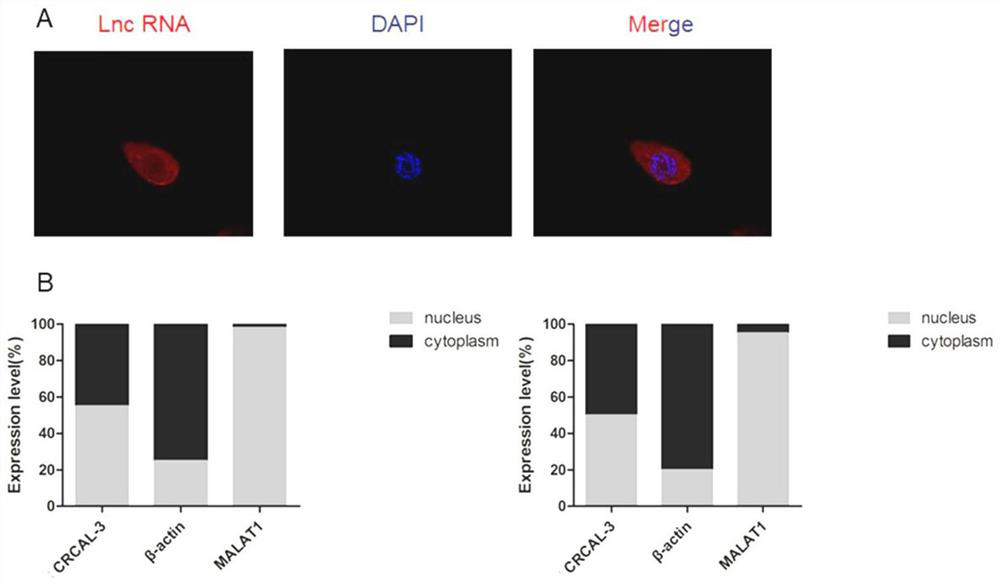Application of long-chain non-coding RNA CRCAL-3 inhibitor in preparation of product for treating radiotherapy-resistant breast cancer
A long-chain non-coding and inhibitor technology, applied in the field of biomedicine, can solve problems such as unclear mechanism of action, lack of treatment methods, lack of research on radiotherapy-resistant breast cancer, etc., to improve radiotherapy sensitivity, improve radiotherapy effect, and solve Poor results from treatment
- Summary
- Abstract
- Description
- Claims
- Application Information
AI Technical Summary
Problems solved by technology
Method used
Image
Examples
Embodiment 1
[0046] Acquisition and analysis of long non-coding RNA CRCAL-3
[0047] 1. Construction of breast cancer radiotherapy-resistant cell lines
[0048] In order to solve the clinical problem of radiotherapy resistance in breast cancer, the inventors repeatedly irradiated breast cancer cell lines in a dose-escalation manner until the cells had a stable radiotherapy-resistant phenotype. Specifically, a linear accelerator is used for irradiation, 2 Gy / time, about 2-3 times a week. Further, the radiotherapy-resistant phenotype of the constructed breast cancer radiotherapy-resistant cell lines was verified, that is, the radiotherapy-resistant cell lines and their corresponding parental cell lines were respectively given doses of 0Gy, 2Gy, 4Gy, 6Gy, and 8Gy for radiotherapy. Final colony counts were done according to plate colony formation experiments and cell survival fractions were calculated. Further, the inventors also adopted the single-click multi-target model to fit the dose-su...
Embodiment 2
[0057] Design of specific LNA to knock down CRCAL-3 and validation of its efficiency
[0058] One, if image 3 As shown, CRCAL-3 is located in the nucleus, and it is difficult for ordinary siRNA to enter the nucleus to knock down CRCAL-3;
[0059] 2. Using LNA technology to design and synthesize LNA-CRCAL-3 that knocks down CRCAL-3
[0060] The LNA sequence is: 5'-T*A*C*T*G*G*T*T*G*C*A*G*G*A*T*T-3'(LNA GapmeR); such as Figure 4 As shown, the efficiency of LNA-CRCAL-3 knocking down CRCAL-3 reaches 80-90%; the common siRNA is only 50-55%, and LNA-CRCAL-3 has a more efficient and stable knockdown effect.
Embodiment 3
[0062] cell experiment
[0063] 1. Assess the effect of LNA-CRCAL-3 on the proliferation of breast cancer cells
[0064] The effect of LNA-CRCAL-3 on the proliferation ability of breast cancer cells was evaluated by MTS cell proliferation assay and plate clone formation assay. The experimental results showed that LNA-CRCAL-3 could attenuate the proliferation and clone formation ability of breast cancer cells. like Figure 5 Shown, A and B are the reduced proliferation ability of breast cancer cells after knockdown of CRCAL-3 in MDA-MB-231-Resistant and MCF-7-Resistant (detected by MTS method); C and D are in MDA-MB After knockdown of CRCAL-3 in -231-Resistant and MCF-7-Resistant, the clonogenic ability of breast cancer cells was weakened. (**p<0.01).
[0065] 2. Assessing the effect of LNA-CRCAL-3 on the radioresistance of breast cancer cells
[0066] (1) Label five six-well plates with 0Gy, 2Gy, 4Gy, 6Gy, and 8Gy respectively; collect breast cancer cells transfected with ...
PUM
 Login to View More
Login to View More Abstract
Description
Claims
Application Information
 Login to View More
Login to View More - R&D
- Intellectual Property
- Life Sciences
- Materials
- Tech Scout
- Unparalleled Data Quality
- Higher Quality Content
- 60% Fewer Hallucinations
Browse by: Latest US Patents, China's latest patents, Technical Efficacy Thesaurus, Application Domain, Technology Topic, Popular Technical Reports.
© 2025 PatSnap. All rights reserved.Legal|Privacy policy|Modern Slavery Act Transparency Statement|Sitemap|About US| Contact US: help@patsnap.com



